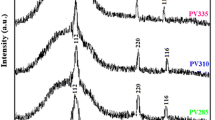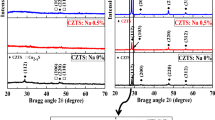Abstract
The physical and optical properties of thin films strongly depend on the film deposition techniques. In this research, Cu2ZnSnS4 (CZTS) thin films were prepared using the sol–gel method and deposited on three kinds of substrates (glass, indium-doped tin oxide (ITO), and fluorine-doped tin oxide (FTO)) by the simple spray pyrolysis method. The influence of the substrate and Cu concentration (0.1 and 0.07 mol/L) on the physical properties of the prepared thin films was examined. The study of X-ray diffraction (XRD) investigation showed that all CZTS thin films possess a single-phase kesterite crystal structure. Field emission scanning electron microscopy (FE-SEM) images showed that the surface of the films was uniform, dense, and had almost no voids, and the particle size of the prepared thin film with the substrate (ITO) was larger than the other samples. The prepared films exhibited an optical band gap ranging from 2 to 2.4 eV. The lowest and highest values of the optical gap correspond to the film with the substrate (ITO) having a lower Cu concentration and the prepared film with the glass substrate having a higher Cu concentration, respectively. The electrical properties and sheet resistance of CZTS thin films were investigated. The best results in terms of electrical properties were related to the ITO substrate with a Cu concentration of 0.1 mol/L. A photoluminescence study showed that the strongest emission peak in the 700–800 nm region was observed for CZTS thin film on ITO substrate. Obtained results indicating the possibility of using the CZTS thin films for efficient and low-cost solar cell and optical applications. Our findings demonstrate that ITO serves as a superior substrate for CZTS fabrication at room temperature. Our results provide an overview of the feasibility of manufacturing optoelectronic devices based on CZTS thin film. Substrate selection is critical in many applications.








Similar content being viewed by others
Data availability
Data will be made available on request.
References
R. Charghandeh, A. Abbasi, Effect of In (O, S) buffer layer on the band alignment and the performance of CZT (S, Se) thin film solar cells. Mater. Today Commun. 37, 107299 (2023)
S. Alamdari et al., Ultra-thin Hafnium doped ZnO films with enhanced optical transparency and electrical conductivity. Mater. Res. Express 6(5), 055020 (2019)
S. Alamdari et al., Green synthesis of multifunctional ZnO/chitosan nanocomposite film using wild Mentha pulegium extract for packaging applications. Surf. Interfaces 34, 102349 (2022)
S. Alamdari, M.J. Tafreshi, M.S. Ghamsari, The effects of indium precursors on the structural, optical and electrical properties of nanostructured thin ZnO films. Mater. Lett. 197, 94–97 (2017)
M. Sasani Ghamsari et al., Impact of nanostructured thin ZnO film in ultraviolet protection. Int. J. Nanomed. 12, 207–216 (2016)
Hw. Zhang, Xh. Liao, Ys. Wang et al., Hybrid fabrication of flexible fully printed carbon nanotube field-effect transistors. J. Mater. Sci. Mater. Electron. 34, 2147 (2023). https://doi.org/10.1007/s10854-023-11585-2
V. Rajeshmon et al., Modification of the optoelectronic properties of sprayed In2S3 thin films by indium diffusion for application as buffer layer in CZTS based solar cell. J. Alloy. Compd. 553, 239–244 (2013)
G. Korotcenkov et al., Peculiarities of SnO2 thin film deposition by spray pyrolysis for gas sensor application. Sens. Actuators, B Chem. 77(1–2), 244–252 (2001)
N. Gruginskie et al., Increased performance of thin-film GaAs solar cells by rear contact/mirror patterning. Thin Solid Films 660, 10–18 (2018)
S. Singh et al., Cholesterol biosensor based on rf sputtered zinc oxide nanoporous thin film. Appl. Phys. Lett. 91(6), 063901 (2007)
L. Yang et al., High-quality conformal homogeneous all-vacuum deposited CsPbCl3 thin films and their UV photodiode applications. ACS Appl. Mater. Interfaces 11(50), 47054–47062 (2019)
A.S. Kalyakina et al., OLED thin film fabrication from poorly soluble terbium o-phenoxybenzoate through soluble mixed-ligand complexes. Org. Electron. 28, 319–329 (2016)
H. Katagiri et al., Development of thin film solar cell based on Cu2ZnSnS4 thin films. Sol. Energy Mater. Sol. Cells 65(1–4), 141–148 (2001)
J.-S. Seol et al., Electrical and optical properties of Cu2ZnSnS4 thin films prepared by rf magnetron sputtering process. Sol. Energy Mater. Sol. Cells 75(1–2), 155–162 (2003)
T. Tanaka et al., Preparation of Cu2ZnSnS4 thin films by hybrid sputtering. J. Phys. Chem. Solids 66(11), 1978–1981 (2005)
M. **e et al., Preparation and characterization of Cu2ZnSnS4 thin films and solar cells fabricated from quaternary Cu–Zn–Sn–S target. Int. J. Photoenergy (2013). https://doi.org/10.1155/2013/929454
Cazzaniga, A.C., Fabrication of thin film CZTS solar cells with Pulsed Laser Deposition. 2016.
E. Naranji, M. Aliannezhadi, S. Panahibakhsh, Surface structured silver-copper bimetallic nanoparticles by irradiation of excimer laser pulses to bilayer thin films. Phys. Scr. 98(10), 105529 (2023)
S. Pawar et al., Effect of laser incident energy on the structural, morphological and optical properties of Cu2ZnSnS4 (CZTS) thin films. Curr. Appl. Phys. 10(2), 565–569 (2010)
G. Larramona et al., 8.6% efficient CZTSSe solar cells sprayed from water–ethanol CZTS colloidal solutions. J. Phys. Chem. Lett. 5(21), 3763–3767 (2014)
I. Repins et al., Co-evaporated Cu2ZnSnSe4 films and devices. Sol. Energy Mater. Sol. Cells 101, 154–159 (2012)
T. Tanaka et al., Fabrication of Cu2ZnSnS4 thin films by co-evaporation. Phys. Status Solidi C 3(8), 2844–2847 (2006)
K. Wang et al., Thermally evaporated Cu 2 ZnSnS 4 solar cells. Appl. Phys. Lett. 97(14), 143508 (2010)
A.K.S. Gupta et al., Characterizations of extrinsically doped CZTS thin films for solar cell absorbers fabricated by sol-gel spin coating method. Appl. Surf. Sci. Adv. 13, 100352 (2023)
M.Y. Yeh, C.C. Lee, D.S. Wuu, Influences of synthesizing temperatures on the properties of Cu2ZnSnS4 prepared by sol–gel spin-coated deposition. J. Sol-Gel Sci. Technol. 52(1), 65–68 (2009)
Z. Seboui et al., The post-growth effect on the properties of Cu2ZnSnS4 thin films. J. Renew. Sustain. Energy 7(1), 011203 (2015)
U. Visoko, I.P. Son, N. Celice, High-efficiency perovskite solar cells improved with low-cost orthorhombic Cu 2 Znsns 4 as the hole-transporting layer. Mater. Tehnol. 52(4), 483–486 (2018)
H. Tong et al., Effects of pre-alloying process on the absorber quality for Cu2ZnSnS4 thin-film solar cells. Mater. Sci. Semicond. Process. 165, 107699 (2023)
Jirage, S., D. Bhuse, and V. Bhuse, Simplest synthesis and characterization study of flower-like Cu2ZnSnS4 thin films. Materials Today: Proceedings, 2023.
Aka, A.H., et al. Comparative study between CZTS and CZTSe thin layers for photovoltaic applications. in E3S Web of Conferences. 2023. EDP Sciences.
Y. Huang et al., Facile solution deposition of Cu2ZnSnS4 (CZTS) nano-worm films on FTO substrates and its photoelectrochemical property. Appl. Surf. Sci. 364, 148–155 (2016)
G.S. Ekbote et al., Development of a flexible piezoelectric and triboelectric energy harvester with piezo capacitive sensing ability from barium tungstate nanorod-dispersed PVDF nanofabrics. Flexible and Printed Electron. 8(2), 025011 (2023)
E. Umar et al., Improved catalytic and bactericidal behavior with in silico molecular docking analysis of barium/chitosan doped tungstate oxide nanoplates. Surf. Interfaces 38, 102835 (2023)
M.Ç. Ersundu et al., Physical, mechanical and gamma-ray shielding properties of highly transparent ZnO-MoO3-TeO2 glasses. J. Non-Cryst. Solids 524, 119648 (2019)
G.-X. Liang et al., Influence of annealed ITO on PLD CZTS thin film solar cell. Surf. Coat. Technol. 358, 762–764 (2019)
M. Aliannezhadi, S.Z. Mirsanaee, M. Jamali, F Shariatmadar Tehrani, The physical properties and photocatalytic activities of green synthesized ZnO nanostructures using different ginger extract concentrations. Sci. Reports 14(1), 2035 (2024)
M. Aliannezhadi, S.Z. Mirsanai, M. Jamali, F.S. Tehrani, Optical and structural properties of bare MoO3 nanobelt, ZnO nanoflakes, and MoO3/ZnO nanocomposites: the effect of hydrothermal reaction times and molar ratios. Optical Mater. 147, 114619 (2024)
M.I. Al-Shemri, M. Aliannezhadi, M.J. Al-Awady, R.A. Ghaleb, Interaction of different lasers beams with synthesized H2Ti3O7 nanotubes: toward photodynamic therapy. Optical and Quantum Electron. 55(8), 671 (2023)
Funding
The authors have not disclosed any funding.
Author information
Authors and Affiliations
Contributions
Sadegh Azadmehr: Experimental studies, manuscript preparation, characterization analysis; Sanaz Alamdari: Edit & Review of the whole manuscript and characterization results; Majid Jafar Tafreshi: Review and Editing; Mohammad Reza Fadavi Eslam: Supervisor and review.
Corresponding authors
Ethics declarations
Competing interests
The authors declare that they have no known competing financial interests or personal relationships that could have appeared to influence the work reported in this paper.
Ethical approval
The experiments carried out in this study did not involve human tissue.
Additional information
Publisher's Note
Springer Nature remains neutral with regard to jurisdictional claims in published maps and institutional affiliations.
Rights and permissions
Springer Nature or its licensor (e.g. a society or other partner) holds exclusive rights to this article under a publishing agreement with the author(s) or other rightsholder(s); author self-archiving of the accepted manuscript version of this article is solely governed by the terms of such publishing agreement and applicable law.
About this article
Cite this article
Azadmehr, S., Fadavieslam, M.R., Tafreshi, M.J. et al. Substrate and Cu concentration-dependent physical properties of spray-deposited Cu2ZnSnS4 thin films: a comparative study. J Mater Sci: Mater Electron 35, 855 (2024). https://doi.org/10.1007/s10854-024-12499-3
Received:
Accepted:
Published:
DOI: https://doi.org/10.1007/s10854-024-12499-3




